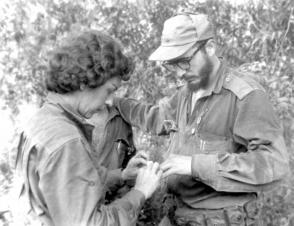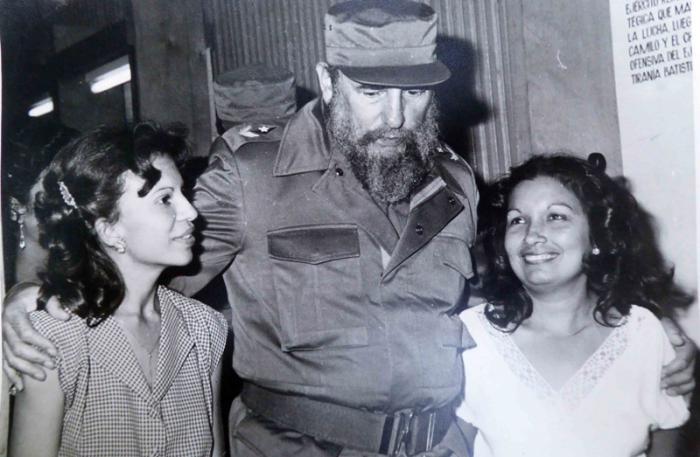Her memory lives on

Fecha:
Fuente:
Autor:
Maritza relates every story about Celia as if she had lived it herself. And the beautiful wooden house is her greatest pride, made clear as she recalls the moment Fidel decided that the national museum dedicated to "the most authentic flower of the Revolution" would be established here.
"I heard that the Comandante said: Let it be in Media Luna! Ay, you can't imagine the emotion, hearing that our greatest dream, that these country girls had struggled for, would come true."
Maritza Acuña Núñez speaks in the name of four other women - Marlene, Alina and Guillermina - who along with Eulalia, in charge of cleaning, opened the Celia Sanchez birth home as a municipal museum in 1983.
"The little hall devoted to the heroine consisted of just a few photos and an ashtray of the family's. From the very beginning, we felt that the place had much more to offer, that the latent testimony within the house, where Celia was born and grew for 20 years, was the best place to perpetuate her memory," says Maritza, the museum's first director.
In just a few minutes, she recalls, along with Marlene Guerra, the three-year odyssey of trips to Havana, the interviews with so many people, and the responses that made clear that a decision about the Celia Sanchez Museum would only be made by Fidel.
"So there you have it, it meant talking with him, seeing him, telling him," and the women calmed down, confident that the moment would come, and it did - in December of 1986.
"Fidel visited Granma on the occasion of the 30th anniversary of the historic meeting in Cinco Palmas, and we hoped that, upon returning from the commemoration, he would come by the house, a municipal museum then."

"We got everything ready, including the plan to tell him, under whatever circumstances, the absolute necessity of supplying the site with more valuable objects from Celia's life, which were in the hands of relatives and the Council of State's Office of Historic Affairs," she continued.
"Around six in the evening, tired of waiting the entire day, an escort had just about buried our hopes, apologizing that Fidel would not come. I was barefoot, I felt like I would die sitting on a chair, and just about to cry, the news of another escort shook me: Hurry, hurry, the Jefe is already here!
"I don't remember how I put my shoes on. Automatically I went from the greatest disappointment to the excitement of a wish come true, and when I got to the main hall, I was hypnotized by that jubilant smile, greeting the people crowded in the street, climbing the stairs with such chivalry, such a gentleman, so elegant, so Fidel."
She recalls her nervousness as she conducted the tour and focuses on a moment in Celia's room.
"Fidel was deeply moved, with his hands behind his back, contemplating the original portrait by Carlos Enríquez of Dr. Manuel Sánchez, Celia's father, and then the photos of her. I did not dare interrupt him. I had to respect that instant of so many emotions that I saw in his eyes, and in his silence.
"Then came the demonstration of his magnificent memory, of the family love he felt for his comrades in the struggle, when facing a very deteriorated photo, in a showcase along with a rifle, he asked me not to tell him, and remembered after a few seconds: This is Captain Raúl Podio, a brave young man who fell in Rejondones de Báguanos. I was dazzled."

"Exactly. Dazzled," Marlene said as she took up the story, "That's how she was when Alina touched me and said: Look at her, she's in limbo. She's not going to say anything to him. You say something, girl.
"I didn't dare either, but he was observing everything, and noticed our murmuring and asked. I said, Comandante, it's that we want to talk with you. You surely noticed that we only have a few things of Celia's, and we would like to devote a room to her personal possessions…
"He immediately called Pedro Álvarez Tabío and said to him: Pedro, take care of what these compañeras are saying. This is how he was given the most satisfying task of his life. Pedro was a fervent investigator of Celia's life, and along with us, the most enthusiastic promoter of the idea that her memorial be located in Media Luna."
Three more years transpired with the Sanchez home as a municipal museum, years of efforts to expand the tribute to the heroine, until in 1990, the site was designated a National Monument, and the following April, Pedro arrived with the answer to their dreams.
"Immersed in a capital restoration, the house was practically torn down, and under a tree in the yard, Pedro asked if we could finish the work within the 26 days that remained before May 9," Maritza recalls.
"I told him that all the construction materials were a sure thing, and then after a moment of suspense, he let go the surprise: If we can raise the house in 26 days, this will be the Celia Sánchez Manduley Memorial-Museum."
"All of a sudden, everything was mixed up with laughter, cries, pinches, and hugs. The emotion of the news was only comparable to the moment when we saw the truck arrive and unload the entire collection of 239 museum-quality objects that belonged to her and her family. It was practically a month of all-nighters, that culminated in the erection of the graphics, the responsibility of Pepe Linares, and the text by Álvarez Tabío. All new."
By the 70th anniversary of her birth, the "brand new" wooden house opened its doors as the Celia Sánchez Manduley Birth Home Museum-Memorial, the principal Cuban institution devoted to perpetuating the memory of the first woman combatant to join the revolutionary guerillas in the Sierra Maestra.






